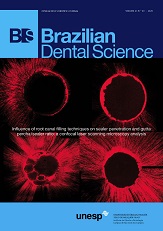Assessment of Mesial Canals Morphology of Mandibular First Molars Using CBCT: An In-vitro Study
DOI:
https://doi.org/10.14295/bds.2020.v23i3.1907Abstract
Objective: The current study aimed to investigate the relationship between canal configuration, distance between mesiobuccal (MB) and mesiolingual (ML) orifices and the degree of canals curvature in the mesial root of permanent mandibular first molars in a sample of Sudanese population using cone-beam computed tomography (CBCT). Material and Methods: A total of 143 extracted mandibular first molars were processed and scanned with CBCT to determine the configuration of the mesial root canals according to the Vertucci classification. The interorificial distance and the degree of canal curvature in clinical (CV) and proximal (PV) views using Schneider technique were assessed. Results: The commonest canal configuration was type IV (53.1%). The interorificial distance was significantly shorter in type VI compared to other types (P < 0.05). Significant association was found for type IV between the MB and ML canal in the primary curvature regarding CV and PV, and for type II regarding PV in primary and secondary curvature (P < 0.05). In type IV the degree of secondary curvature of MB canal regarding PV, and in the ML canal in CV was significantly lower compared to other types (P < 0.05). Significant correlation was seen in PV of primary curvature in the MB for type VI (P < 0.05). Conclusion: The interorificial distance and secondary curvatures in CV for MB canal were found to be key factors for predicting root canal patterns in PV.
Keywords
Canal morphology; Canal curvature; Interorificial distance; Mandibular molars.
Downloads
Downloads
Additional Files
Published
How to Cite
Issue
Section
License
Brazilian Dental Science uses the Creative Commons (CC-BY 4.0) license, thus preserving the integrity of articles in an open access environment. The journal allows the author to retain publishing rights without restrictions.
=================




























